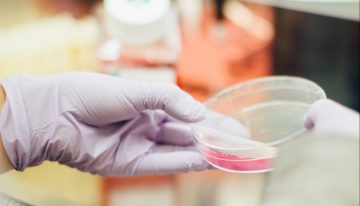By Victoria Peters
Scientists can now relish in the joy of farming, bringing fresh, ”homegrown” food to their family’s table! The relatively new field of science known as cellular agriculture focuses on the production of agricultural products from cell cultures. Honing in on techniques used in biotechnology and molecular and synthetic biology, scientists can produce proteins, tissues and fats all from the lab bench. In fact, this year marks the 7-year anniversary since the first lab grown hamburger was cooked and consumed (Ghosh, 2013)! However, science has come a long way since then as we now have the ability to produce beef, poultry, pork and even seafood, entirely in the lab (Schaefer, 2018).
Just how do we take cells from a petri dish and produce a delicious, juicy steak? There are generally three stages to the in-house culturing of meat (Siegelbaum, 2018). The first stage requires selecting and acquiring the starter cells which can include embryonic stem cells, adult stem cells or myoblasts. The selection of the starter cells is a balancing act between a cell type that is highly replicative and also not too difficult or costly to differentiate into the desired tissue. In this regard, this usually means myoblasts take the cake! The second critical component to the success of cultured meat is the selection of growth medium. Nutrients and growth factors comprising the medium are integral elements for the successful production of cultured meat and moreover, tend to take up a hefty portion of the budget. The medium must support the differentiation of the starting culture and promote tissue growth. Another crucial aspect for culturing meat is the structure – scaffold – on which the cells are grown. The scaffold is the component that will direct the overall 3-dimensional architecture of the meat. The scaffold should therefore move periodically to stretch and relax the developing muscle to stimulate the cells to differentiate into muscle. Interestingly, the scaffold also must allow for vascularization for the development of normal muscle tissue (Edelman, 2005). Seems like a challenging task!

There are claims that from just 10 muscle cells, scientists could culture 50,000 tons of meat within 2 months (Gayle, 2010). What’s more interesting is that if cultured properly, meat could be produced indefinitely without introducing new cells from a living organism. This could be the solution society is looking for to combat our current environmental impact that our carnivorous diet is having. The Good Food Institute has claimed that lab-cultured meat would reduce land usage by 99% and water usage by 98% (Tuomisto, 2011). Not only would this new method of producing meat be more environmentally friendly, but it may also indeed be healthier for the consumer. Researchers have claimed that this cultured form of food decreases the exposure of meat, and thus the consumer, to dangerous bacteria, disease and excessive ingestion of antibiotics. Furthermore, this meat will reduce exposure to chemicals, pesticides and fungicides used with conventional farming. Lastly, with this method of meat production, producers can fortify the cultured meat with various nutrients and grow the meat to have different ratios of fats and protein, allowing the meat to be customized to any dietary requirement (VI, 2018). The science doesn’t stop at meat products; current research is being undertaken to develop lab grown egg whites and milk protein!
As always, there are some drawbacks that need to be considered. Three major issues are cost, scaling up production to meet consumers’ needs, and public acceptance (Hopkins, 2015). Surveys in North America and the UK have proven there are concerns with safety in terms of consumption and taste (Hocquette, 2015). It will be interesting to see how biotech companies overcome these challenges as this product becomes more readily available in the future.
If I’ve piqued your interest in this newly emerging field of science, you can find out more about a Vancouver-based biotech company, Appleton Meats that is employing a fleet of biologists and technologists to craft their own lab-grown meat.
- 1. Edelman, P. D., McFarland, D. C., Mironov, V. A., & Matheny, J. G. (2005). Commentary: In vitro-cultured meat production. Tissue engineering, 11(5-6), 659-662.
- Gayle, D. (2012, January 17). Test-tube meat could become a reality this year as scientists work out how to make it profitable. Retrieved from https://www.dailymail.co.uk/sciencetech/article-2087837/Test-tube-meat-reality-year-scientists-work-make-profitable.html
- Ghosh, P. (2013, August 5). World’s first lab-grown burger is eaten in London. Retrieved from https://www.bbc.com/news/science-environment-23576143.
- Hocquette J (2015) Is it possible to save the environment and satis- ify consumers with artificial meat? J Integr Agric 14:206–207. https://doi.org/10.1016/S2095-3119(14)60961-8
- Hopkins PD (2015) Cultured meat in western media: the disproportionate coverage of vegetarian reactions, demo- graphic realities, and implications for cultured meat market- ing. J Integr Agric 14:264–272. Https://doi.org/10.1016/S2095 -3119(14)60883-2
- Schaefer, G. O. (2018, September 14). Lab-Grown Meat. Retrieved from https://www.scientificamerican.com/article/lab-grown-meat/
- Siegelbaum, D. J. (2008, April 23). In Search of a Test-Tube Hamburger. Retrieved from http://content.time.com/time/health/article/0,8599,1734630,00.html?imw=Y
- Tuomisto, H. L., & Mattos, M. J. T. D. (2011). Environmental Impacts of Cultured Meat Production. Environmental Science & Technology, 45(14), 6117–6123. doi: 10.1021/es200130u
- VI, J. R. H. (2018, September 28). Raising animals for meat creates lots of problems. Lab-grown meat could provide solutions. Retrieved from https://massivesci.com/articles/why-lab-grown-meat-cellular-agriculture/


